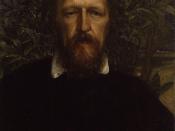�PAGE � �PAGE �2� Holland
Dawn Holland
John Lowery
ENG 425
22 October 2014
Frost's Place in Poetic Traditions
Alfred Tennyson (1809-1892) and Robert Frost (1874-1963) were both poets from different literary eras. Tennyson wrote with more of a Modernist perspective, while Frost wrote from a decidedly Romantic perspective. This being the case, both writers had shared characteristics which belonged to the other school of thought. Tennyson's "Break, Break, Break" (1834) and Frost's "Desert Places" (1936) are fitting examples of the crossing and intermingling of poetic literary canons, and the sharing of certain characteristics.
Tennyson's poem "Break, Break, Break" (1834) is a poem which depicts one man's grief at the loss of a loved one. This is a 16 line poem, separated into 4 stanzas, written more in the Modernist genre. The Modernist aspects include using words as symbols rather than literally. The following line "And the stately ships go on" (Tennyson, 1834) is representative of how life continues in spite of loss.
Then there is writing as one would speak with another as opposed to how one would read "And I would that my tongue could utter The thoughts that arise in me" (Tennyson, 1834). One must also add the use of loss or exile as themes "But O for the touch of a vanish'd hand, And the sound of a voice that is still!" (Tennyson, 1834). Other literary elements found within this poem are apostrophe when the speaker addresses the sea directly "BREAK, break, break, On thy cold gray stones, O Sea!" (Tennyson, 1834), alliteration "â¦boat on the bayâ¦day that is dead" (Tennyson, 1834), enjambment "And the stately ships go on To their haven under the hill" (Tennyson, 1834), and onomatopoeia "â¦breakâ¦shoutsâ¦sings" (Tennyson, 1834). All these elements combined speak towards the Romantic elements of individualism and...


